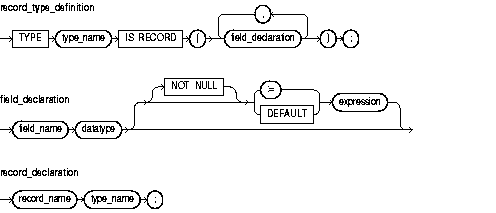| PL/SQL User's Guide and Reference 10g Release 1 (10.1) Part Number B10807-01 |
|
|
View PDF |
| PL/SQL User's Guide and Reference 10g Release 1 (10.1) Part Number B10807-01 |
|
|
View PDF |
Records are composite variables that can store data values of different types, similar to a struct type in C, C++, or Java. For more information, see "What Is a PL/SQL Record?".
In PL/SQL records are useful for holding data from table rows, or certain columns from table rows. For ease of maintenance, you can declare variables as table%ROWTYPE or cursor%ROWTYPE instead of creating new record types.
Syntax

Keyword and Parameter Description
A datatype specifier. For the syntax of datatype, see "Constants and Variables".
A combination of variables, constants, literals, operators, and function calls. The simplest expression consists of a single variable. For the syntax of expression, see "Expressions". When the declaration is elaborated, the value of expression is assigned to the field. The value and the field must have compatible datatypes.
A field in a user-defined record.
At run time, trying to assign a null to a field defined as NOT NULL raises the predefined exception VALUE_ERROR. The constraint NOT NULL must be followed by an initialization clause.
A user-defined record.
A user-defined record type that was defined using the datatype specifier RECORD.
Initializes fields to default values.
Usage Notes
You can define RECORD types and declare user-defined records in the declarative part of any block, subprogram, or package.
A record can be initialized in its declaration:
DECLARE
TYPE TimeTyp IS RECORD ( seconds SMALLINT := 0, minutes SMALLINT := 0,
hours SMALLINT := 0 );
You can use the %TYPE attribute to specify the datatype of a field. You can add the NOT NULL constraint to any field declaration to prevent the assigning of nulls to that field. Fields declared as NOT NULL must be initialized.
DECLARE
TYPE DeptRecTyp IS RECORD
(
deptno NUMBER(2) NOT NULL := 99,
dname departments.department_name%TYPE,
loc departments.location_id%TYPE,
region regions%ROWTYPE
);
dept_rec DeptRecTyp;
BEGIN
dept_rec.dname := 'PURCHASING';
END;
/
To reference individual fields in a record, you use dot notation. For example, you might assign a value to the field dname in the record dept_rec as follows:
dept_rec.dname := 'PURCHASING';
Instead of assigning values separately to each field in a record, you can assign values to all fields at once:
You can assign one user-defined record to another if they have the same datatype. (Having fields that match exactly is not enough.) You can assign a %ROWTYPE record to a user-defined record if their fields match in number and order, and corresponding fields have compatible datatypes.
You can use the SELECT or FETCH statement to fetch column values into a record. The columns in the select-list must appear in the same order as the fields in your record.
You can declare and reference nested records. That is, a record can be the component of another record:
DECLARE
TYPE TimeTyp IS RECORD ( minutes SMALLINT, hours SMALLINT );
TYPE MeetingTyp IS RECORD (
day DATE,
time_of TimeTyp, -- nested record
dept departments%ROWTYPE, -- nested record representing a table row
place VARCHAR2(20),
purpose VARCHAR2(50) );
meeting MeetingTyp;
seminar MeetingTyp;
BEGIN
seminar.time_of := meeting.time_of;
END;
/
You can assign one nested record to another if they have the same datatype:
seminar.time_of := meeting.time_of;
Such assignments are allowed even if the containing records have different datatypes.
User-defined records follow the usual scoping and instantiation rules. In a package, they are instantiated when you first reference the package and cease to exist when you end the database session. In a block or subprogram, they are instantiated when you enter the block or subprogram and cease to exist when you exit the block or subprogram.
Like scalar variables, user-defined records can be declared as the formal parameters of procedures and functions. The restrictions that apply to scalar parameters also apply to user-defined records.
You can specify a RECORD type in the RETURN clause of a function spec. That allows the function to return a user-defined record of the same type. When calling a function that returns a user-defined record, use the following syntax to reference fields in the record:
function_name(parameter_list).field_name
To reference nested fields, use this syntax:
function_name(parameter_list).field_name.nested_field_name
If the function takes no parameters, code an empty parameter list. The syntax follows:
function_name().field_name
Example
The following example defines a RECORD type named DeptRecTyp, declares a record named dept_rec, then selects a row of values into the record:
DECLARE
TYPE DeptRecTyp IS RECORD (
deptno departments.department_id%TYPE,
dname departments.department_name%TYPE,
loc departments.location_id%TYPE );
dept_rec DeptRecTyp;
BEGIN
SELECT department_id, department_name, location_id INTO dept_rec
FROM departments WHERE department_id = 20;
END;
/
Related Topics